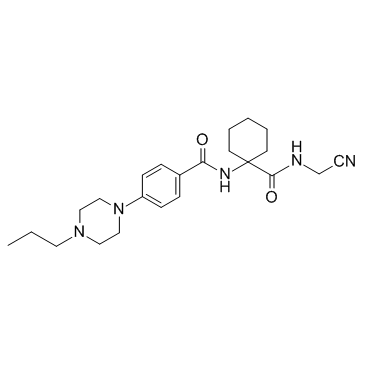
Balicatib
CAS No. 354813-19-7
Balicatib( AAE581 )
Catalog No. M14213 CAS No. 354813-19-7
Balicatib is an inhibitor of cathepsin K with IC50 value of 1.4nM .
Purity : >98% (HPLC)
 COA
COA
 Datasheet
Datasheet
 HNMR
HNMR
 HPLC
HPLC
 MSDS
MSDS
 Handing Instructions
Handing Instructions
| Size | Price / USD | Stock | Quantity |
| 2MG | 32 | In Stock |


|
| 5MG | 50 | In Stock |


|
| 10MG | 91 | In Stock |


|
| 25MG | 212 | In Stock |


|
| 50MG | 397 | In Stock |


|
| 100MG | 572 | In Stock |


|
| 500MG | 1197 | In Stock |


|
| 1G | Get Quote | In Stock |


|
Biological Information
-
Product NameBalicatib
-
NoteResearch use only, not for human use.
-
Brief DescriptionBalicatib is an inhibitor of cathepsin K with IC50 value of 1.4nM .
-
DescriptionBalicatib is an inhibitor of cathepsin K with IC50 value of 1.4nM.Balicatib is highly selective against cathepsin K over cathepsin B, L and S in the in vitro enzyme assay. However, the selectivity is not so high in cell-based enzyme assay. The lysosomotropic character of balicatib results in its accumulation in lysosomes and the subsequent nonselective off-target effects. The off-target effects also cause the skin adverse events of balicatib. As a cathepsin K inhibitor, balicatib is developed for osteoporosis. It has been reported to reduce the biochemical markers of bone resorption and increase bone mineral density in ovariectomized monkeys.(In Vitro):Balicatib (0-10 μM) shows less than 1.5-fold accumulation of Type I collagen at concentrations up to 10 μM in human dermal fibroblasts.(In Vivo):Balicatib (0, 3, 10, 50 mg/kg; Oral gavage; twice daily for 18 months) partially prevented ovariectomyinduced changes in bone mass, inhibited bone turnover at most sites, and had an stimulatory effect on periosteal bone formation in cynomolgus monkeys.
-
In VitroBalicatib (0-10 μM) shows less than 1.5-fold accumulation of Type I collagen at concentrations up to 10 μM in human dermal fibroblasts.
-
In VivoBalicatib (0, 3, 10, 50 mg/kg; Oral gavage; twice daily for 18 months) partially prevented ovariectomyinduced changes in bone mass, inhibited bone turnover at most sites, and had an stimulatory effect on periosteal bone formation in cynomolgus monkeys. Animal Model:11-13 years, female cynomolgus monkeys (Macaca fascicularis)Dosage:0, 3, 10, 50 mg/kg Administration:Oral gavage; twice daily for 18 months Result:Completely prevented ovariectomy-induced increases in BFR/BS in cancellous bone of vertebra and femur and in osteonal and endocortical bone of vertebra, significantly decreased bone formation rates.
-
SynonymsAAE581
-
PathwayProteasome/Ubiquitin
-
TargetCysteine Protease
-
RecptorCathepsin K
-
Research AreaMetabolic Disease
-
Indication——
Chemical Information
-
CAS Number354813-19-7
-
Formula Weight411.54
-
Molecular FormulaC23H33N5O2
-
Purity>98% (HPLC)
-
SolubilitySoluble in DMSO
-
SMILESO=C(NC1(C(NCC#N)=O)CCCCC1)C2=CC=C(N3CCN(CCC)CC3)C=C2
-
Chemical NameN-(1-((cyanomethyl)carbamoyl)cyclohexyl)-4-(4-propylpiperazin-1-yl)benzamide
Shipping & Storage Information
-
Storage(-20℃)
-
ShippingWith Ice Pack
-
Stability≥ 2 years
Reference
1. Jerome C, et al. Osteoporos Int. 2012 Jan;23(1):339-49.
molnova catalog



related products
-
Aurantiamide acetate
Aurantiamide acetate was isolated from the fermentation broth of Aspergillus penicilloides for the first time. Aurantiamide acetate is a selective and orally active cathepsin inhibitor. Aurantiamide acetate has anti-inflammatory activities and can be used for the study of inflammatory diseases.
-
Nampt-IN-1
Nampt-IN-1 (LSN3154567) is a potent and selective NAMPT inhibitor. Nampt-IN-1 inhibits purified NAMPT with an IC50 of 3.1 nM.
-
K777
K777 is an orally active and irreversible cysteine protease inhibitor. K777 is a broad-spectrum antiviral by targeting cathepsin-mediated cell entry.



 Cart
Cart
 sales@molnova.com
sales@molnova.com


